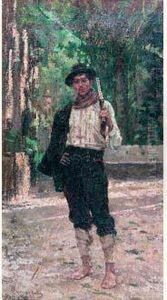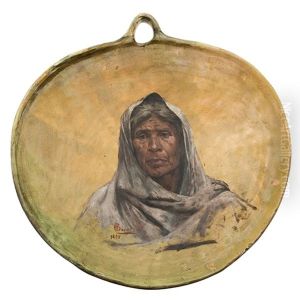Henrique Bernardelli Paintings
Henrique Bernardelli was a prominent Brazilian painter, sculptor, and teacher, born on July 15, 1857, in Valparaíso, Chile, to Italian parents. When he was still a child, his family moved to Brazil, and it was there that Bernardelli would develop his artistic career and contribute significantly to the country's cultural scene.
Bernardelli was part of a generation of artists who were instrumental in the renewal of fine arts in Brazil. He was the older brother of Rodolfo Bernardelli, who also became a celebrated sculptor. Henrique began his artistic education at the Imperial Academy of Fine Arts in Rio de Janeiro, where he studied under painters such as Victor Meirelles and Jules Le Chevrel. His talent was recognized early on, and he was awarded a travel prize to Europe, where he furthered his studies.
In Europe, Bernardelli spent time in Italy and Paris, being influenced by the artistic movements of the time. He absorbed the techniques of Realism and Naturalism, which would later be reflected in his works. After returning to Brazil in the early 1880s, he established himself as a prominent artist, receiving numerous commissions and participating in important exhibitions.
Throughout his career, Bernardelli was known for his historical paintings, portraits, and genre scenes. His work often depicted moments from Brazilian history, as well as everyday life and the diverse people of Brazil. In addition to his painting, he was also an accomplished sculptor, with several public monuments to his credit.
Bernardelli's influence extended beyond his own creations; he was a dedicated teacher and served as a professor at the National School of Fine Arts (the successor of the Imperial Academy) for many years. There, he played a crucial role in the education of a new generation of Brazilian artists. His teaching and his work helped shape the development of fine arts in Brazil during a period of significant change and modernization.
Henrique Bernardelli's legacy is that of a pioneering artist whose work captured the spirit of his time and helped to define Brazilian national identity through art. He died on April 6, 1936, in Rio de Janeiro. Today, his works are displayed in various museums and collections, both in Brazil and abroad, and he is remembered as one of the leading figures of Brazilian art history.



